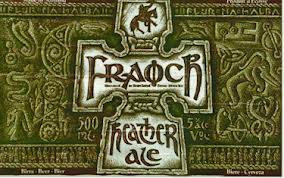 Almost ten years ago, I tried a bottle of something called Fraoch Ale, from Scottish Brewer Williams Brothers, who specialized in traditional Celtic ales. They made beer with gooseberry, pine needles and various other ancient beer ingredients. Fraoch, of course, is Gaelic for Heather, as in the Scottish lowland ground cover with tiny pink flowers. It was long used by middle age brewers instead of hops.
Almost ten years ago, I tried a bottle of something called Fraoch Ale, from Scottish Brewer Williams Brothers, who specialized in traditional Celtic ales. They made beer with gooseberry, pine needles and various other ancient beer ingredients. Fraoch, of course, is Gaelic for Heather, as in the Scottish lowland ground cover with tiny pink flowers. It was long used by middle age brewers instead of hops.
One taste of that beer opened my awareness about what might be possible. Soon after I tried my hand at brewing my own Heather Ale. In the years that have followed I have brewed successive versions of my Heather Ale numerous times, winning a handful of competition medals for it along the way. My version these days is a far cry from the original Fraoch I sampled. Mine is darker and fuller with a lot more heather character to it, including a substantial dry-hopping of heather (dry-heathering??). I almost completely replace hops with heather, except for a tiny amount at the beginning of the boil to aid preservation and stability (hops are a strong preservative).
Fraoch hasn’t been available in Alberta for a number of years, since they pulled out of the market. So, when I was in Scotland this past summer, I made a point of picking up a bottle to bring home. I opened it up recently to see if it still did something for me.
It pours pale yellow with a slight haze. A moderate white head drops to a thin blanket quickly, although leaving behind some nice lacing. The aroma is soft and earthy with a floral character. I also detect light pilsner malt sweetness and a genteel fruitiness. Very fresh, delicate nose.
Upfront the beer gives over an expected soft, grainy sweetness with a honey accent and a touch of soft fruit. It comes across as a pleasant, lightly bitter pilsner, except with a more earthy character. The heather is subtle, adding an earthy, rustic note with a touch of peat. But the beer is quite balanced and very drinkable. It doesn’t have a traditional bitterness, but does have an earthy, rounded bitter that sneaks up on you.
It is what I remember it to be. They do a great job of infusing heather without destroying the beeriness of the beer. The soft grainy malt holds up against a subtle heather bitterness and creates a very drinkable beer. After my years of brewing a far more assertive interpretation, I could allow myself to be disappointed by the lack of heather intensity. Instead I choose to appreciate its balance and quiet subtlety. Someone who drinks regular lager might be unwittingly persuaded to try this beer and quite enjoy it. Yet, those in the know will appreciate the heather notes. Nice beer.
Very different then my versions, but isn’t that the joy of brewing? It is a deserving inspiration for what I did with it over numerous batches. I am glad it continues to shine.

Leave a Reply